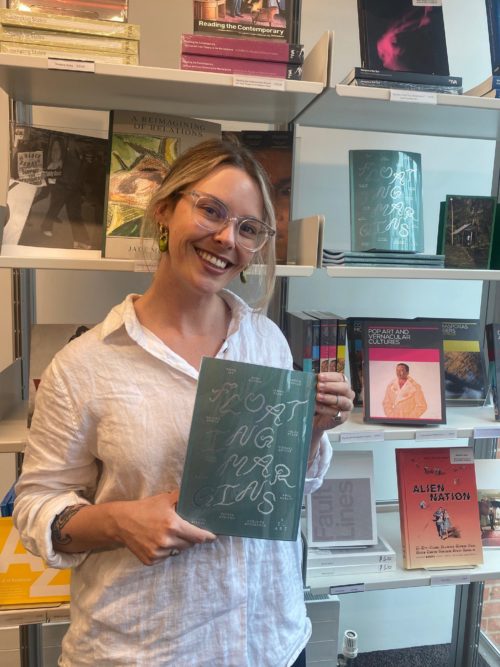
Kirsty Flockhart with publication Floating Margins in Stuart Hall Library, 2022.
Based on her recent master’s thesis, Stuart Hall Library volunteer Kirsty Flockhart reviews the politics of nationalism in the current organisation of the Venice Biennale.
The global art scene is always dominated by the powerful countries; the same geopolitics that governs the world governs the art scene
-artist Hit Man Gurung from Kathmandu, Nepal
The Venice Biennale features exhibitions through a format of ‘national pavilions’, where the space dedicated to each participating country is dependent on various economic and political factors[1]. The major permanent pavilions are situated within the gated-grounds of the Giardini, many of which have historic links to colonialism and now feature exceptional economic prowess. The rest are forced into renting temporary spaces within the Arsenale. Beyond this, there are many other non-biennale-sanctioned countries whose exhibitions are scattered across the city. This is one of the largest problems; the implication of equal representation at the ‘Olympics of the Art World’[2], and the reality that each pavilion heavily relies on access to funding to determine its place.
The format of national pavilions seems an impossible task: to represent a nation with just one or a few individuals. Biennales claim to represent national contemporary culture, which is particularly complex, as culture is experienced and interpreted differently between each region, community or individual. With ever increasing international movement, we should expect ideas of national identity to become ever more complicated. By maintaining the system of national pavilions, there is also a continuing issue with national identities and their representation being flattened into binary constructs. By using a structure which emulates our current notions of nationhood – defined by physical territories – we inevitably end up excluding many communities of stateless people, diaspora, refugees and economic migrants.
The disparities between pavilions are disheartening and a continuous issue. The wealthiest pavilions exist in the main Arsenale and Giardini locations, whereas the rest are dispersed in less prominent sites around the city of Venice, which often only the most determined visitors are able to find. These smaller pavilions are often only found by chance.[3] There have been counter-exhibitions, such as the Diaspora Pavilion[4] (2017), but the depth of inequality makes us question to what extent these initiatives can be successful. These issues of wealth are also echoed by the concerning amount of Golden Lion winners dominated by EU-US states[5].
Is it possible for global biennials to act as sites for positive changes? Over the past few decades, many biennales have subtly dropped off the use of national pavilions, opting instead for large mixed international exhibitions[6]. This change allows organisers to feature more diverse artists without monopolising space as a single country.
In light of this development, where does the Venice Biennale currently position itself and how do alternative pavilions critique its current nationalist structure? In 2022, the French Pavilion[7] featured London-based Franco-Algerian artist Zineb Sedira who interrogates notions of nationalism and identity. The Nordic Pavilion is reinterpreted as ‘The Sámi Pavilion’[8] to celebrate the art and sovereignty of the Indigenous Sámi people. Here Venice can be seen explicitly complicating the notions of nationhood, but they seem reluctant to give up the format any time soon.
Another example of rethinking the national pavilions is iniva’s 2022 ‘DRIFT – a post-national digital pavilion’[9]. Alternative to large scale artworks, we see complex dialogue and discussion being highlighted through their online ‘micro-site’. The project aims to take advantage of digital accessibility which exists beyond physical borders, through a publishing project, a podcast and a commissioned soundscape. Rather than depending on the physical sites at Venice, DRIFT offers a distinctly intimate experience where audiences access it through their personal devices and earphones. If the global pandemic has shown us anything in the art world, it’s necessitated digital access to the arts and communities. The post-national digital pavilion enables us to explore varying discussions and research (though we should note that many participants lack equal access to technology and the internet, and digitising pavilions may not solve all the issues of physical pavilions). The project is divided into three key concept themes: The River, The Island and The Coastline, which open up critical conversations on the importance of historical migration and the residual power dynamics of colonialism.
Overall, DRIFT is a captivating and poetic look into the complications of identity and nationhood, and we see and hear artists who reflect upon the long term socio-political impacts of global movement across waters.
Biography
Kirsty Flockhart is a volunteer at Stuart Hall Library and a recent graduate of Curating Contemporary Art at Royal College of Art. As an artist and curator, she is interested in using art to explore the political and reviewing how art practices reflect polotical moments and cultural movements.
References
[1]Kazmin, A. and Ghiglione, D. (2022) Venice Biennale: how do countries get a pavilion? Online: https://www.ft.com/content/dbe8d297-113a-4202-99b1-ee6c49ca58d2 [accessed 20/10/2022]
[2] Shurvell, J. (2022) Venice Biennale 2022: Highlights From The Olympics Of The Art World. Online: https://www.forbes.com/sites/joanneshurvell/2022/04/26/venice-biennale-2022-top-eighteen-highlights/ [accessed 20/10/2022]
[3]Higgie, J. (2022) How Venice’s National Pavilions Complicate the Notion of Citizenship. In: Frieze, issue 126. Online: https://www.frieze.com/article/states-in-progress [accessed 20/10/2022]
[4] International Curators Forum (2017) Diaspora Pavilion. Online: https://www.internationalcuratorsforum.org/diaspora-platform/ [accessed 20/10/2022]
[5] Wikipedia (2022) List of Venice Biennale. Online: https://en.wikipedia.org/wiki/List_of_Venice_Biennale_exhibitions [accessed 20/10/2022]
[6] Sumba, E. O. (2022) Why the Venice Biennale Model Is Obsolete. Online: https://contemporaryand.com/magazines/why-the-venice-biennale-model-is-obsolete/ [accessed 20/10/2022]
[7] La Biennale di Venezia (2022) France. Les rêves n’ont pas de titre / Dreams have no titles https://www.labiennale.org/en/art/2022/france
[8] Office of Contemporary Art Norway (2022) The Sámi Pavilion. Online: https://oca.no/thesamipavilion [accessed 20/10/2022]
[9] iniva (2022) Drift – a post-national digital pavilion. Online: https://iniva.org/programme/projects/drift-a-digital-european-pavilion/ [accessed 20/10/2022]